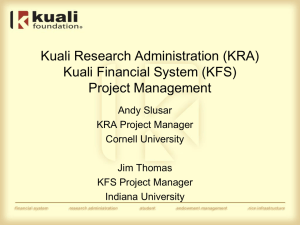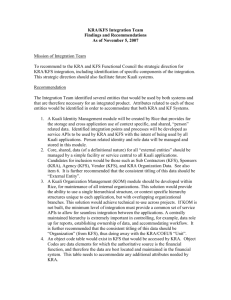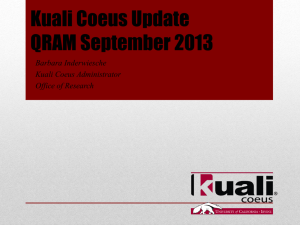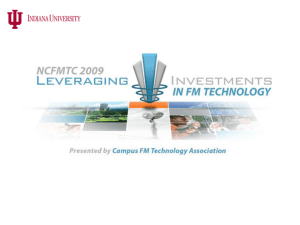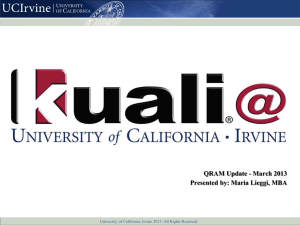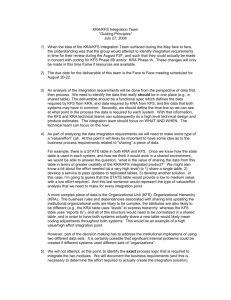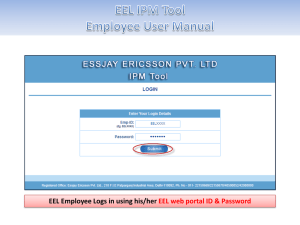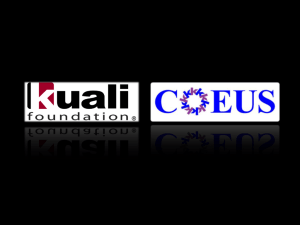Execution & Monitoring
advertisement
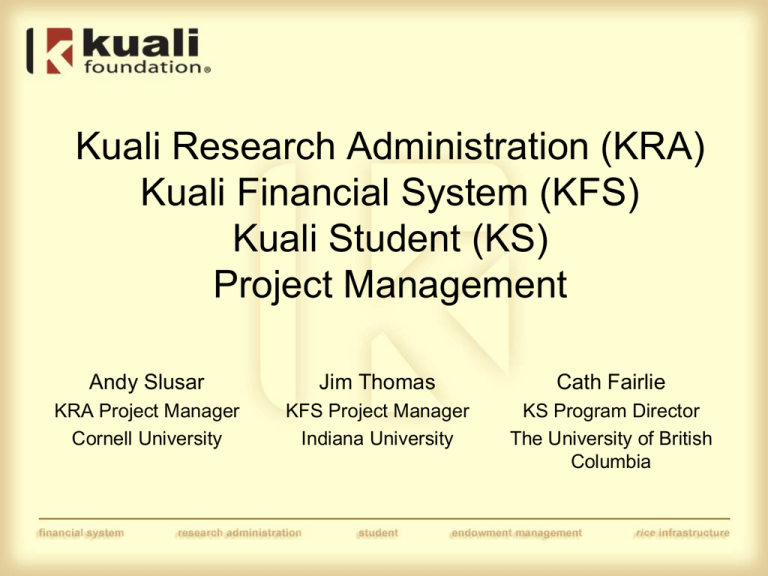
Kuali Research Administration (KRA) Kuali Financial System (KFS) Kuali Student (KS) Project Management Andy Slusar Jim Thomas Cath Fairlie KRA Project Manager Cornell University KFS Project Manager Indiana University KS Program Director The University of British Columbia Effective PM? What is effective PM? According to Project Management Institute: • Initiation and Planning • Execution and Monitoring • Closing – transition to Sustainment Agenda • Initiation and Planning • Execution and Monitoring • Sustainment • Open Source Misconceptions KRA/KFS/KS Project Differences • Project differences – KFS started with IU FIS – KRA and the Coeus relationship – KS started with a vision – Team size/project scope – User community differences – Rice Evolution/Extraction • Effective project management essential to all KFS & KRA Initiation Guiding Principles • KFS based on Indiana’s FIS • KRA based on MIT’s Coeus • Scope Statement is the developments team’s “contract” with functional stakeholders • Functional Changes are approved by the respective Functional Council • Technical Standards are governed by the Kuali Technical Council (KTC) KFS & KRA Initiation Guiding Principles (cont.) • Maximize commonality of business practices • Make configurable as much as possible given time and resource constraints • Burden of proof falls on advocates for change to show benefits exceed costs • All changes subject to “The Reality Triangle” KS Initiation • Development of a detailed Project charter – Contract between the partners – Mission, objectives & vision – Technical Architecture guiding principles – Functional Scope – Development approach (SOAD) – Governance & organization – Project management methodology - Agile methodology Phased Modular Approach Functional Stream Adjust plans and repeat for Releases 2/3/4 Oct 2008 Nov 2008 Contract Design R1 (Infrastructure & Curriculum Development) Application Architecture - Process models - ER models - High Level Service Models - Domain Definitions Service Modeling R1 (Infrastructure & Curriculum Development) Program Management & Communications Aug 2007 Service Modeling R2 (Domain 2) Contract Design R2 (Domain 2) May 2009 July 2009 Aug 2009 Technical Stream Technical Architecture -Technology proofs -SOA standards Development Infrastructure - Developers workbench - Procedures - Standards Develop Configuration Application - Configuration Infrastructure -Proof of concept Pilot Software Design & Development R1 (Infrastructure & Domain 1) Release 1 & Implement Test Re-plan / Re-Architect / Implement & Transition to Support Execution & Monitoring The Reality Triangle Scope (Functional Council) Schedule (Time) (Project Mgr) Resources (Capacity) (Board) Execution & Monitoring The Other Realities COST RISK Execution & Monitoring Tools Tools in a distributed environment – Confluence from Atlassian (wiki pages for documentation, collaboration, etc) – Sakai (document sharing, email archive, etc) – Omniplan, MS Excel and Project for project plans and Gantt charts – JIRA from Atlassian (task tracking) – Resource planning sheets (KFS/KRA) Execution & Monitoring Tools Execution & Monitoring Tools Execution & Monitoring Tools Execution & Monitoring Tools Execution & Monitoring Tools Execution & Monitoring Tools Execution & Monitoring Tools Execution & Monitoring Building Capacity Project Resources • Clear role definitions • Developer resources • Functional resources • Training Execution & Monitoring Managing Costs • Monthly cost reporting by institution, by cost category by program year to Board – Detailed – Executive Summary • Budget/ actual/ forecast reports $$ and FTE counts • Variance analysis Execution & Monitoring Managing Costs Actual/Forecast to Complete (FTE Count) Cost Category Institutional Contribution Employee Name Doris Yen Heather Johnson Cindy Nahm Audrey Lindsay Len Carlsen Zdenek Zraley Joe Yin George Lindholm Leo Fernig Gord Uyeda Chiu, Hanson Doug Loewen Jing Cui Contractor Name Cath Fairlie Richard Spencer Total Personnel Cost Actual/Forecast to Complete ($$) 2007 2008 JUL AUG SEP OCT NOV DEC JAN FEB MAR APR MAY JUN 0.3 0.3 1.0 0.7 0.5 0.5 0.5 0.0 3.0 1.5 0.7 0.8 1.0 0.7 1.0 1.0 1.0 0.0 0.8 0.6 1.0 0.6 1.0 1.0 1.0 0.0 0.9 0.8 1.0 0.6 1.0 1.0 1.0 0.2 1.0 1.0 1.0 0.6 1.0 1.0 1.0 0.2 1.0 1.0 1.0 0.6 1.0 1.0 1.0 0.2 1.0 1.0 1.0 0.6 1.0 1.0 1.0 1.0 1.0 1.0 1.0 0.6 1.0 1.0 1.0 1.0 1.0 1.0 1.0 0.6 1.0 1.0 1.0 1.0 1.0 1.0 1.0 0.6 1.0 1.0 1.0 1.0 1.0 1.0 1.0 0.6 1.0 1.0 1.0 1.0 1.0 1.0 1.0 0.6 1.0 1.0 1.0 1.0 0.4 0.2 1.0 0.4 0.2 1.0 0.4 0.2 1.0 0.4 0.2 1.0 0.4 0.2 1.0 3.0 3.0 14.3 1.0 1.0 JUL AUG $2,349 $2,737 $8,181 $8,636 $4,199 $3,489 $3,476 $0 $33,504 $16,029 $0 $0 $0 SEP $5,482 $7,300 $8,181 $8,636 $8,399 $6,978 $6,953 $0 $0 $0 $0 $0 $0 OCT $6,265 $5,475 $8,181 $7,402 $8,399 $6,978 $6,953 $0 $0 $0 $0 $0 $0 Y1 Forecast Resource Cost FTE Months 2008 NOV $7,048 $7,300 $8,181 $7,402 $8,399 $6,978 $6,953 $1,606 $0 $0 $0 $0 $0 DEC $7,832 $9,125 $8,181 $7,402 $8,399 $6,978 $6,953 $1,606 $0 $0 $0 $0 $0 JAN $7,832 $9,125 $8,181 $7,402 $8,399 $6,978 $6,953 $1,606 $0 $0 $0 $0 $0 FEB $7,832 $9,125 $8,181 $7,402 $8,399 $6,978 $6,953 $8,032 $0 $0 $0 $0 $0 MAR $7,832 $9,125 $8,181 $7,402 $8,399 $6,978 $6,953 $8,032 $0 $0 $2,647 $1,808 $6,632 APR $7,832 $9,125 $8,181 $7,402 $8,399 $6,978 $6,953 $8,032 $0 $0 $2,647 $1,808 $6,632 MAY $7,832 $9,125 $8,181 $7,402 $8,399 $6,978 $6,953 $8,032 $0 $0 $2,647 $1,808 $6,632 $7,832 $9,125 $8,181 $7,402 $8,399 $6,978 $6,953 $8,032 $0 $0 $2,647 $1,808 $6,632 6.2 6.0 6.5 6.8 6.8 7.6 9.2 9.2 9.2 9.2 9.2 1.0 1.0 1.0 1.0 1.0 1.0 1.0 1.0 1.0 1.0 1.0 1.0 1.0 1.0 0.4 1.0 1.0 0.4 1.0 1.0 0.4 1.0 1.0 1.0 1.0 1.0 1.0 $7,832 $9,125 $8,181 $7,402 $8,399 $6,978 $6,953 $8,032 $0 $0 $2,647 $1,808 $6,632 10.7 10.5 12.0 7.4 11.5 11.5 11.5 6.6 3.0 1.5 2.0 1.0 5.0 $83,799 $95,810 $98,176 $91,291 $96,585 $80,252 $79,959 $53,012 $33,504 $16,029 $13,233 $9,041 $33,158 3.0 3.0 0.0 100.2 $79,988 $22,687 $0 $886,524 $185,277 $51,929 $49,654 $53,868 $56,476 $56,476 $62,902 $73,988 $73,988 $73,988 $73,988 $73,988 $6,702 $5,154 $0 $0 $0 $0 $0 $11,856 $8,548 $370 $0 $0 $0 $0 $0 $8,918 $572 $0 $0 $0 $0 $0 $0 $572 $6,839 $486 $0 $0 $0 $0 $0 $7,325 $7,418 $1,406 $4,675 $0 $0 $0 $0 $13,499 $0 $0 $0 $0 $0 $0 $0 $0 $2,257 $4,195 $0 $0 $0 $0 $0 $6,452 $0 $0 $0 $0 $0 $0 $0 $0 $6,503 $4,434 $22,182 $0 $0 $0 $0 $33,120 $8,000 $0 $0 $0 $0 $0 $0 $8,000 $12,500 $0 $0 $0 $0 $0 $0 $12,500 $8,000 $6,000 $0 $0 $0 $0 $0 $14,000 $197,133 $60,847 $50,225 $61,193 $69,976 $56,476 $69,354 $73,988 $107,108 $81,988 $86,488 $87,988 100.2 $67,339 $22,045 $26,857 $0 $0 $0 $0 $116,241 $1,002,765 $11,168 $10,686 $11,168 $10,686 $11,168 $10,686 $11,168 $10,686 $11,168 $10,686 $11,168 $10,686 $11,168 $10,686 $11,168 $10,686 $11,168 $10,686 $0 $0 $0 $0 $0 $0 $0 $0 $0 $0 $0 $0 $0 $0 $0 $0 $0 $0 $11,168 $10,686 $6,000 $0 $0 $11,168 $10,686 $4,500 $0 $0 $11,168 $10,686 $4,500 $0 $0 12.0 12.0 3.2 0.0 0.0 $134,016 $128,234 $15,000 $0 $0 12.0 3.5 0.0 42.7 $281,249 $62,629 $0 $621,128 42.7 $24,209 $11,950 $43,151 $2,796 $0 $0 $3,000 $85,106 $706,234 Contractor Name Cath Fairlie Valerie Johnson 1.0 1.0 1.0 1.0 0.4 1.0 0.4 1.0 0.2 1.0 0.6 1.0 0.7 1.0 0.6 1.0 0.6 1.0 1.0 $10,116 $23,496 $25,337 $31,924 $8,750 $30,236 $11,156 $20,886 $3,197 $23,420 $9,141 $28,625 $13,669 $10,409 $7,715 $25,600 $9,000 $25,600 $25,600 Total Personnel Cost 3.0 3.0 3.0 3.4 3.4 3.2 3.6 4.1 4.0 4.0 4.0 4.0 $31,970 $45,350 $47,191 $62,528 $63,247 $45,937 $54,415 $64,148 $39,978 $62,454 $51,954 $51,954 $3,762 $0 $0 $2,796 $0 $0 $0 $6,558 $1,352 $2,390 $0 $0 $0 $0 $3,000 $6,742 $0 $0 $0 $0 $0 $0 $0 $0 $1,303 $1,766 $0 $0 $0 $0 $0 $3,069 $5,174 $3,794 $0 $0 $0 $0 $0 $8,968 $0 $0 $0 $0 $0 $0 $0 $0 $0 $0 $43,151 $0 $0 $0 $0 $43,151 $0 $0 $0 $0 $0 $0 $0 $0 $2,618 $0 $0 $0 $0 $0 $0 $2,618 $0 $0 $0 $0 $0 $0 $0 $0 $5,000 $4,000 $0 $0 $0 $0 $0 $9,000 $5,000 $0 $0 $0 $0 $0 $0 $5,000 $38,529 $52,093 $47,191 $65,597 $72,215 $45,937 $97,566 $64,148 $42,596 $62,454 $60,954 $56,954 Other Program Costs Travel & Accommodation Other (Hosted Meetings, Meals, Misc.) Hardware - Development Environment Software Licenses Project Team Training Training and Communication Materials Consulting Expertise Total Other Costs Total Program Level Expense Y1 Budget Resource Cost FTE Months Y1 Variance Resource Cost FTE Months JUN $79,988 $22,687 Other Program Costs Travel & Accommodation Other (Hosted Meetings, Meals, Misc.) Hardware - Development Environment Software Licenses Project Team Training Training and Communication Materials Consulting Expertise Total Other Costs Total Institutional Contribution Program Level Expense Employee Name Leo Fernig Gord Uyeda Kristina Batiste 2007 96.0 $872,400 -4.2 -$14,124 $125,000 $10,000 96.0 $135,000 $1,007,400 -4.2 $57,661 -$12,045 -$26,857 $0 $0 $0 $0 $18,759 $4,635 0.0 $0 -42.7 -$621,128 -42.7 -$24,209 -$11,950 -$43,151 -$2,796 $0 $0 -$3,000 -$85,106 -$706,234 0.0 $0 $0 Execution & Monitoring Managing Costs Y1 Forecast FTE Months Resource Cost Program Costs Staff/Resource Costs (Labour) Travel & Accommodation Other (Hosted Meetings, Meals, Misc.) Hardware - Development Environment Software Licenses Project Team Training Training and Communication Materials Consulting Expertise Contingency Total Program Costs Program Contributions University of XXXX University of XXXX University of XXXX University of XXXX University of XXXX University of XXXX University of XXXX Total Founder & Partner Contributions Cash Contributions Andrew W. Mellon Foundation Request CANARIE Funding Proposal Total Program Contributions Funding Shortfall 506.3 Y1 Budget FTE Months 531.2 506.3 $5,148,128 $392,992 $101,912 $113,532 $46,308 $40,000 $34,000 $101,000 $250,000 $6,227,871 100.2 117.5 90.1 96.7 26.4 19.5 4.4 454.7 $1,016,549 $1,254,456 $1,171,226 $931,024 $538,101 $328,099 $38,867 $5,278,322 Resource Cost Y1 Variance FTE Months Resource Cost 24.9 531.2 $4,952,116 $577,500 $53,000 $80,000 $40,000 $40,000 $80,000 $128,000 $600,000 $6,550,616 24.9 -$196,012 $184,508 -$48,912 -$33,532 -$6,308 $0 $46,000 $27,000 $350,000 $322,745 96.0 100.0 102.0 100.0 28.0 30.0 18.0 474.0 $1,007,400 $1,001,417 $992,333 $983,500 $496,000 $304,300 $174,000 $4,958,950 4.2 17.5 -12.0 -3.3 -1.6 -10.5 -13.6 -19.3 $9,149 $253,039 $178,893 -$52,476 $42,101 $23,799 -$135,133 $319,372 $500,000 $0 $500,000 $250,000 $0 -$250,000 $5,778,322 -$449,549 $5,708,950 -$841,666 $69,372 $392,117 Execution & Monitoring Managing Risk • Identifying, analyzing, and responding to project risk. • minimize the consequences of adverse events, which may prevent the project from meeting its objectives. • identify the highest-priority risks –focus on them as the project evolves • a dynamic and proactive process that requires continuous vigilance. • Risk Assessment: • Risk Index = Impact X Probability • Risk Mitigation: • Activities to lower the probability of the risk • Activities to lower the impact of the risk Execution & Monitoring Managing Risk Ref. # 1. 2. Impact on Project Prob. Of Occurring Risk Index 1=Low 2=Med 3=High 1=Low 2=Med. 3=High (Risk x Prob.) Technology Risk: A Service Oriented Architecture implemented using Web Services is a relatively new technology set. Lack of experience within the founding institutions and within the industry for these technologies. Design mistakes leading to significant problems at the development stage Design and development take longer than expected as problems are worked out May be system performance issues with the new technology Costs increase 3 3 9 Business Analysis Risk: Project team members are inexperienced with the concepts and guidelines of Service Orientation. Service modeling and service design skills not available. Methodology is new and not well understood. Results in services that are too tightly coupled and a reduction in flexibility in the system Don’t realize the expected benefits of service composition or development agility 3 Risk Item Description And Potential Consequence or Impact Impact Horizon Risk Plan Resolution Required Date Mitigate Accept Avoid Near Mitigate Planned Mitigation Activities Forecast Risk / Expected Outcome After Actions Completed Develop a QA strategy and plan Conduct architectural reviews with industry experts at critical project milestones RISK: 3 X 3 = 9 Ensure all parties are fully familiar with the concepts of Service-Orientation. This includes business stakeholders as well as applications managers and developers Formal project team training Contract experienced resources RISK: 3 X 2 = 6 Current Status / Actions Taken To-Date 3 9 Near Mitigate Conducted architectural reviews at end of planning phase by IBM and Sosnoski Arrangements made with IBM and SUN to conduct a second external review at end of Architecture (Feb 2008) Project kick-off meeting to overview SOA approach IBM presentations on SOMA IBM experts participating in workshops Business Analysts contracted by institutions who lack that skill set Continue to develop and document the methodology to be used. Mentoring provided from skilled resources to less skilled resources during the application architecture phase. IBM contacted to work with the team to review and comment on the methodology. Additional resources will be contracted to increase the SOA expertise on the team. Resources being sought from IBM and other sources. Communications • Good project management requires effective communications & collaboration • Good communications requires: – A strategy and a plan – Communication/collaboration tools – Effective meetings Collaboration in a Distributed Environment! Collaboration in a Distributed Environment! Collaboration • Collaboration is hard work. It requires: – – – – – – Governance Excellent communications Relationship building – Respect & Trust Commitment Team Goals vs. Institutional Wants Complementary competencies – everyone brings something different to the table • Result - more creative solutions • KIT – cross project collaboration and integration Collaboration Tools • Blending Collaboration Tools - the right tool at the right time – Face to face meetings or workshops – Video Conference/Skype video – Breeze (Adobe Connect) – Telephone / Skype audio conference – Chat/IM – Email Meetings/Status Reporting • In person meetings are a good communication vehicle for reporting status and resolving issues • • • • • • • • • • Board Functional Council Technical Council Project Leadership meetings Developer meetings Code Reviews One on ones Face to Face meetings Focus groups Informal Effective Meetings • • • • Have an agenda Record Action Items Track and follow up Formation of ad hoc subgroups Sustainment • Closing the project involves transitioning to sustainment • Kuali projects are rapidly approaching completion and full transition into sustainment model – several implementation projects in the works • Kuali Foundation Board working aggressively to define a detailed Sustainment model – Team structure, resources, capacity – Funding model – Support processes Open Source Misconceptions • • • • • Part time developers Not industrial strength Not well tested Hap-hazard governance No documentation Kuali Community Source Kuali Community Source • • • • • • • • Full Time Dedicated Development Teams Dedicated Functional Resources Built for reliability and scalability Intensive QA/Testing process Structured and well documented governance process Extensive functional and technical documentation Partner Institutions dedicated to the success of Kuali! Commercial Affiliates available to provide expertise How are we doing? • KFS • KRA • KS Working together We can do it!! Kuali Project Management Questions? http://www.kuali.org
